Lea Wait's Blog, page 24
December 17, 2024
Grateful by Matt Cost
I am grateful for readers, writers, reviewers, podcasters, bookstores, libraries, and every single person of the wonderful community of books that I find myself immersed within.
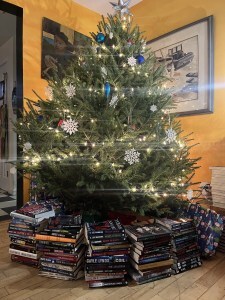
These are just some of the books I have read written by friends.
Encircle Publications published my first book, I am Cuba, in March of 2020. It has been quite a ride. Over that time, I have met so many literary people. In 2019, I attended Crime Wave in Portland, Maine. It was as if a light bulb had exploded from my head with the inscription inside stating wow, these are my people.

The other day, I was walking out of the grocery store into the parking lot, and a car pulled over, the window went down, and a woman asked if I were Matt Cost. Thinking it was somebody I knew, I leaned in the passenger window and said hi to her dog. As it turns out, I did not know her, but she just wanted to say how much she loves my books and that she has read every single one of the sixteen of them. People—that stuff means the world to us writers.
This past Sunday, I was invited to the house of Jule Selbo where she and Gabriela Stiteler were hosting a holiday gathering of writers from Sisters in Crime. There were nine of us there, a few who I knew, a few who I got to know, and a fabulous time was had by all. A major topic was getting creepy correspondences or gifts. What else would crime writers talk about?
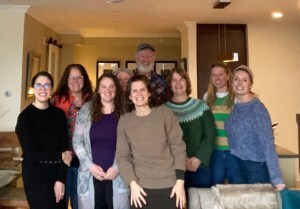
Whether it is a noir at the bar reading, a crime conference, a panel discussion on writing, or just an impromptu gathering, it is always a fabulous time to get together with my people. Those who write crime and spend their days researching odd and strange and illegal information to then spill out onto the pages as murder, theft, fraud, and general all-around depravity.
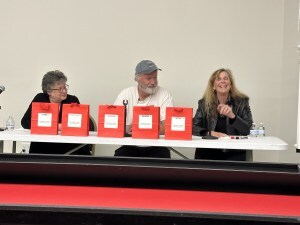
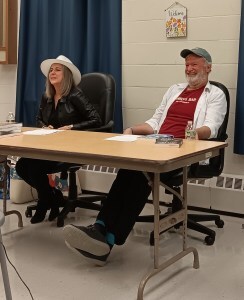
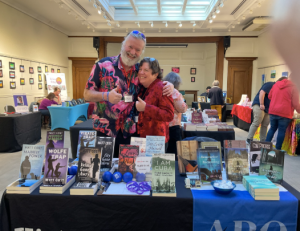
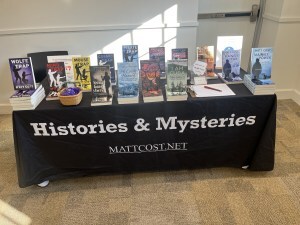
Over the past five years, I have established a wonderful relationship with many book reviewers. Many of these literary people are regulars, dutifully reviewing the three books a year that I have been publishing over this last half-decade. I have met a few of them at book presentations or conferences, but most, I know by name and review only. All the same, I feel a tie to them that is real, a friendship that exists.
Five years ago, I’d never heard of a podcaster. My first foray into the world of radio and podcast was on the House of Mystery Radio with Al Warren. What a fantastic time talking books on the air with other authors and lovers of literature. Since then, there have been many other great podcast talks that I have participated in. I am a regular on Big Blend Radio. Last week, Julie Hennrikus reached out to me to interview me for her podcast for Sisters in Crime. What a wonderful experience.
There are many marvelous bookstores in the world. Sherman’s Maine Coast Book Shop has nine stores scattered across the state, and I’d like to send a special kudos out to them for how wonderful they have been to me at every step of my evolution as a writer. They carry and sell all my books. They have me come do signings and participate in book events. A couple of weeks ago they sat me at a table signing books with the amazing Tess Gerritsen. Thank you.
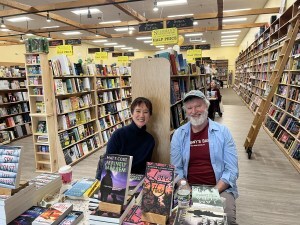
This past spring into fall, I did over fifty speaking engagements. There was a rotary club, a few retirement communities and whatnot, but the bulk of them were libraries. Libraries are the absolute hub of every community. Usually centered in town, in some wonderfully unique building, filled with books and lovers of books, these institutions are the backbone of our towns. To be given the opportunity to visit these fantastic places around New England, meet the wonderful people who work there, and engage with their patrons is truly an honor.
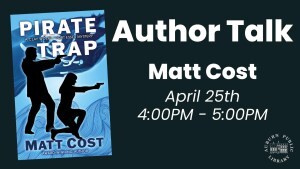
So, to the incredibly sensational writing community, I’d like to say thank you, I’m grateful, happy holidays, and here’s to an astonishing New Year to come. Write on.
About the Author
Matt Cost was a history major at Trinity College. He owned a mystery bookstore, a video store, and a gym, before serving a ten-year sentence as a junior high school teacher. In 2014 he was released and began writing. And that’s what he does. He writes histories and mysteries.
Cost has published six books in the Mainely Mystery series, starting with Mainely Power. He has also published five books in the Clay Wolfe Trap series, starting with Wolfe Trap. And finally, there are two books in the Brooklyn 8 Ballo series, starting with Velma Gone Awry. For historical novels, Cost has published At Every Hazard and its sequel, Love in a Time of Hate, as well as I am Cuba.
Cost now lives in Brunswick, Maine, with his wife, Harper. There are four grown children: Brittany, Pearson, Miranda, and Ryan. They have been replaced in the home with four dogs. Cost now spends his days at the computer, writing.
December 15, 2024
Enter Late, Leave Early: Making Thrillers More Thrilling
Rob Kelley here, thinking about upping the stakes in mysteries, suspense, and thrillers.
 I’ve been working on revising my third novel (title TBD) and have been thinking about the suspense-heightening technique “Enter Late, Leave Early” (ELLE), as illustrated with Dick Wolf’s television show “Law and Order.” The credits finish rolling, you get the “dun-dun” sound, the scene opens, there’s a minute of dialogue or a little action, then someone is dead. No screwing around, no lead up, just the minimum to set the scene, and we’re off. That’s Enter Late. Same thing on the back end: Leave Early. The district attorney and their staff maneuver, respond, and strategize then the jury returns the verdict. Case closed. Maybe we see a very brief dialogue on the courthouse steps. And we’re done.
I’ve been working on revising my third novel (title TBD) and have been thinking about the suspense-heightening technique “Enter Late, Leave Early” (ELLE), as illustrated with Dick Wolf’s television show “Law and Order.” The credits finish rolling, you get the “dun-dun” sound, the scene opens, there’s a minute of dialogue or a little action, then someone is dead. No screwing around, no lead up, just the minimum to set the scene, and we’re off. That’s Enter Late. Same thing on the back end: Leave Early. The district attorney and their staff maneuver, respond, and strategize then the jury returns the verdict. Case closed. Maybe we see a very brief dialogue on the courthouse steps. And we’re done.
Master of suspense Alfred Hitchcock said it a different way 65 years ago in a BBC interview:
How does one describe drama? Drama is life with the dull bits cut out.
In fact, ELLE is usually applied to screenwriting. The story starts and ends with a bang, fitting lots of action and excitement into the 45 minute television show or the 2 hour-long feature film.
What does that mean for a novel, though? Well, you can distill down a story to action and dialogue, both of which move quickly. You certainly don’t have to describe every meal a character eats, and you can probably ignore waking up and going to bed for them every day of the narrative.
Instead you start with a death, or an attack, or some other act of violence. Or maybe it starts with a look forward. You see this in television in which a high energy scene starts the show, you get the title card “2 days earlier,” then we learn how we got to the terrorist threat or the character standing on the edge of the roof ready to jump.
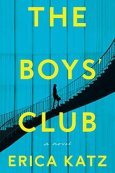 The Boys Club by Erica Katz gives us a taste of that. The book opens with a court transcript and a bit of internal monologue that warns you something terrible has happened to young attorney Alex Vogel in her first few months at a prestigious law firm, resulting in this serious legal action and fearful memories that cause her to “wipe the sweat from [her] brow and close [her] eyes.” The narrative then unfolds with Alex’s meteoric rise in her law firm while we readers are holding our breath knowing that something exceptionally bad is coming. We’re just not sure what it will be or when it will happen.
The Boys Club by Erica Katz gives us a taste of that. The book opens with a court transcript and a bit of internal monologue that warns you something terrible has happened to young attorney Alex Vogel in her first few months at a prestigious law firm, resulting in this serious legal action and fearful memories that cause her to “wipe the sweat from [her] brow and close [her] eyes.” The narrative then unfolds with Alex’s meteoric rise in her law firm while we readers are holding our breath knowing that something exceptionally bad is coming. We’re just not sure what it will be or when it will happen.
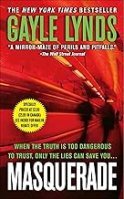 But we need not go to the future to increase narrative tension. An author can open right up with incredibly high stakes that draw the reader in. For example, the first chapter of Gayle Lynds’ international spy thriller Masquerade portrays the memory-challenged protagonist, Liz Sansborough, inexplicably under attack by intruders. And when Sansborough is handed a gun, knowing what it is–an automatic–and even more surprisingly to herself, knowing how to use it, we have a literal opening with a bang. That high tension moment anchors the subsequent revelations of conspiracy and deceit which the reader is desperate to unravel along with Liz.
But we need not go to the future to increase narrative tension. An author can open right up with incredibly high stakes that draw the reader in. For example, the first chapter of Gayle Lynds’ international spy thriller Masquerade portrays the memory-challenged protagonist, Liz Sansborough, inexplicably under attack by intruders. And when Sansborough is handed a gun, knowing what it is–an automatic–and even more surprisingly to herself, knowing how to use it, we have a literal opening with a bang. That high tension moment anchors the subsequent revelations of conspiracy and deceit which the reader is desperate to unravel along with Liz.
As a reader, I really enjoy Enter Late, Leave Early, but, as a writer, I’m often challenged to answer the question how do you actually do that?
It may just be me, but I almost never pull off Enter Late in my first draft. I usually do a lot of what I call throat clearing. Who is my protagonist? What brought them to this particular set of circumstances? Why do they react the way they do? Why are they a beer drinker and not a wine drinker? All the stuff you may need to have considered, but that doesn’t need to be in the final opening of your book. In the end, it may never make it into the book at all. Instead, in revision, you might take this fully-formed character with their history and their habits and drop them straight into the fire.
And Leave Early? Ideally, you wrap up the major plot points, and the characters face their uncertain future, no epilogue, no happily ever after, at least not entirely. Some things are broken, some people are dead, and maybe there’s hope and resilience, but no certainty.
That’s at the level of the book, but to really crank up the action, writers wanting to create high narrative tension apply ELLE at the chapter level, with each chapter starting strong and ending strong, with a cliffhanger or killer scene. This is one of the features of a real page-turner. You know, the book that you are still reading at midnight thinking, “yeah, I can live with one less hour of sleep as long as I know what happens next!”
I’ve opened my books with a murder by an anonymous mob thug, an assassination of a Mexican politician by cartels, and the mass murder of striking miners in Africa by government troops and a private military contractor. Each of those violent acts comes around to threaten my very ordinary and vulnerable protagonists here at home, making their lives very, very difficult.
What are some of your favorite high octane openings of suspense, murder mysteries, and thrillers, dropping you right into the action and wanting more?
December 13, 2024
Weekend Update: December 14-15, 2024
 Next week at Maine Crime Writers there will be posts by Rob Kelley (Monday), Matt Cost (Tuesday), Kaitlyn Dunnett/Kathy Lynn Emerson (Thursday) and Maureen Milliken (Friday).
Next week at Maine Crime Writers there will be posts by Rob Kelley (Monday), Matt Cost (Tuesday), Kaitlyn Dunnett/Kathy Lynn Emerson (Thursday) and Maureen Milliken (Friday).
In the news department, here’s what’s happening with some of us who blog regularly at Maine Crime Writers:
Today, Matt Cost will be at the Bangor Authors’ Fair and Literary Festival at the Bangor Public Library from 10-3:30 with 90 plus other Maine authors. Find him on the third floor sharing a table with author Anne Britting Oleson.
Cost’s audiobook Pirate Trap was recently selected as the best PRIVATE INVESTIGATOR THRILLER by Audio Book Reviewer. Kudos to narrator Jason Arnold for being Clay Wolfe and knocking down the voices of all the characters. From the review: “The narrator, Jason Arnold, seamlessly transitions into each character, maintaining the smooth flow of the narrative. Arnold excels at portraying each character’s traits and maintaining consistency throughout the narrative and across the series. He is intentional in his delivery and intonation. He is truly Clay Wolfe!”
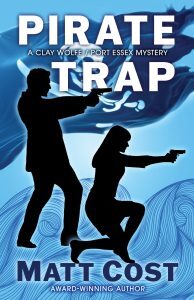
An invitation to readers of this blog: Do you have news relating to Maine, Crime, or Writing? We’d love to hear from you. Just comment below to share.
And a reminder: If your library, school, or organization is looking for a speaker, we are often available to talk about the writing process, research, where we get our ideas, and other mysteries of the business, along with the very popular “Making a Mystery” with audience participation, and “Casting Call: How We Staff Our Mysteries.” We also do programs on Zoom. Contact Kate Flora
The Deep End
Hello crime fiction aficionados,
Do you ever find yourself riding a train or walking to work or waking up in a cold sweat in the middle of the night wondering, what makes a mystery a mystery? How does horror writing intersect with mystery fiction? Is suspense a subgenre or an element of craft? Is it both? In what ways can mystery writers stretch the genre without breaking the rules readers need? What, now that I’m thinking of this, are the conventions that must be followed?
If so – join me. If not – proceed with caution.
What makes a mystery a mystery?
A lot of other people who are pretty brilliant have written extensively about this. (For more, check out this MWA guide or this CrimeReads article about mystery tropes). A quick google yields all sorts of the collective wisdom about tropes and subgenres and conventions. Otto Penzler defines a mystery as “any work of fiction where a crime or threat of crime is central to the plot or theme.” (For more, you can read his CrimeReads article on subgenres in mystery fiction.)
I’ve heard others espouse to a more purist view, saying that “mystery” without any qualifiers can be interpreted to mean “traditional mystery” (think “Golden Age of Detective Fiction”) which entails a murder (or crime), a detective or investigator, clues, and a villain. Some form of justice is meted out at the end and the dead body is more a necessary detail than a fully developed character. The author of a traditional mystery follows the fair game rules and includes other tools of the genre like MacGuffins and red herrings.
I’m curious – what does mystery mean to you? When you think about your own internal barometer, where do you draw the line? Why?
On Tropes
Foundational to any genre are the often loved, often hated tropes. Tropes are common themes or ideas that recur. In the hands of some, they are clichés. All genre fiction leverages tropes to build the guardrails of the story structure and help readers see the rules of the game. Mystery readers are unique in that we love our rules and we also enjoy a well-done twist.
In mysteries tropes may include but are not limited to: locked rooms in which something bad happens, red herrings, unreliable narrators, MacGuffins, amateur sleuths, femme fatales, a sidekick (think Holmes and Watson, Hastings and Poirot, Rizzoli and Isles, Nero and Archie), morally grey detectives, and the list goes on.
I myself am a fan of classic tropes reimagined, especially noir and hard-boiled tropes that explore gender, identity, and power.
In the hands of exceptional writers, a classic trope can be twisted into something else entirely.
I’m curious – what is your stance on tropes? What are your favorites? What do you avoid? Do you have an author who does something very, very well?
If you’re still with me, I invite you a little deeper into the workings of my brain.
You are welcome.
A Visual Representation of the Intersection of Subgenre and Sleuth
In order to explore some of these ideas, I’ve invested a little too much time in building an X-Y paradigm for some of my favorite characters in a series. I’ve taken common subgenres (running from Cozy to Noir with Traditional roughly in the middle) and run them up the Y axis. The sleuth runs from amateur to professional on the X axis.
(See the image I’ve very thoughtfully included. Again, you’re welcome.)
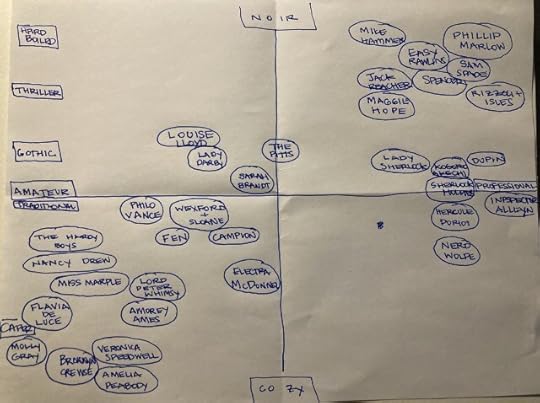
My Findings
I realized that, while some sleuths may start out as amateurs, the more dead bodies they encounter, the more skilled they become. At what point do we say that Miss Marple, who is featured in 12 novels and 20 short stories, is beyond an “amateur” sleuth? I considered adding arrows to indicate growth over time, but this became messy. And sometimes, there is no growth over time. Sometimes the amateur is static.
Secondly, I had definitive clusters of sleuths at different points. I went through a real crisis when trying to determine if police were to the right or left of private investigators. (I decided on right.)
Finally, my top left quadrant is very empty. I have theories about this. Authors like S.A. Cosby, Morgan Talty, Gabino Iglesias, Megan Abbot, and Silvia Moreno-Garcia have stand alone characters that belong in the upper left quadrant. And I wonder if there is something to be said for the upper left quadrant tiptoeing into other spaces? Maybe horror? Literary Fiction?
Perhaps in another entry, I’ll explore the intersection crime with different genres. Maybe a 3 part Venn diagram comparing Red Harvest to Yojimbo to A Fistful of Dollars? I love to see how arts iterates and ultimately reflects the society in which we live.
If you write, where do your characters live? Lower left? Upper right? Somewhere in between? Who did I miss? Where would you put them on this paradigm? What do you think I got wrong and why? Are there any other paradigms you think are worth exploring in crime writing?
Thanks for indulging me and hoping to connect again soon,
Gabi
December 11, 2024
Main Character, Protaganist, and Antagonist … who drives the Action In Your Plot?

Vaughn C. Hardacker
In 2002, I realized there was more to writing than just sitting down and putting words onto a page. I had to learn the craft. One of the first things I learned was that every story, whether it a mystery/crime story, a romance, or even a children’s story, must have, as a bare minimum, two characters: a protagonist and an antagonist. I set out to develop two characters for my first Houston/Bouchard novel, SNIPER. I started with my hero, AKA the protagonist, Michael Houston, and then my villain, the antagonist. To refresh my knowledge of the craft, I started reading DRAMATICA: A New Theory of Story by Melanie Anne Phillips and Chris Huntley (available at dramatica.com). The one thing that immediately struck me was their discussion on characters; they maintain that there are several distinct types of characters in any story: the main character, the protagonist, and the antagonist. They define each as:
Main Character: The player through whom the audience experiences the story firsthand.
Protagonist: The prime mover of the plot.
Antagonist: The character opposed to the protagonist.
In many stories, the hero combines the main character and the protagonist. When taken in the context of the definitions above, it is possible to argue that in most cases (especially in mystery and crime/thriller fiction), the villain better fits the definition of the protagonist. It is the villain, not the so-called hero, who is the prime mover of the plot (this is possibly more likely in the thriller genre). The villain acts first, forcing the hero to react for one reason or another. Throughout much of the story, the villain’s actions are the prime movers of the plot.
Here are a couple of examples:
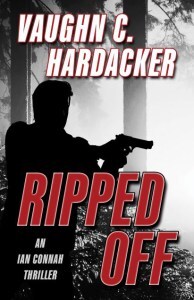
In RIPPED OFF, my most recently published thriller, my main character, retired hitman Ian Connah, walks out of court after his fourth divorce. Intending to pay his lawyer, he contacts his banker, who informs him that he is broke. Harry Sandberg, his financial manager, had absconded with his life savings. Forced to earn enough money to pursue Sandberg, Connah must return to the trade.
In Bram Stoker’s classic Dracula, Count Dracula (antagonist), not Dr. van Helsing (protagonist), drives the plot. Throughout, Dracula is proactive, and van Helsing is reactive.
In each case above, I would argue that the villain is the true protagonist, and the antagonist is the main character or the hero. Who in your story is the protagonist, who is your antagonist, and who is your main character? When I embark on a new project, I spend more time developing the villain than the hero. I was once told: “You write terrific villains, but your heroes are not as strong.” I took that as a compliment. In American Indian culture, the strength of a warrior’s adversaries determined their status within the tribe. Strong enemies force the hero to overcome weaknesses to come out on top.
In your writing, who is the driving force behind the plot? Who is your main character, and who is the true protagonist?
December 9, 2024
AGATHA
by Jule Selbo
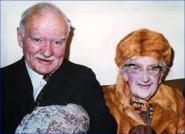
YEP, that Dame Agatha Mary Clarissa Christie ((1890- 1976) also known as Lady Mallowan because she married archeologist Lord Max Mallowan after her first rascally husband cheated on her – she stayed married to Max for 46 years and loved the ‘digs’ they went on). The above is one of my fav photos of them.
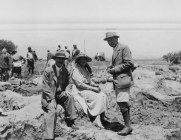
Yep, that Agatha, the British author known for 66 detective novels and 14 short story collections, particularly those revolving around fictional detectives Hercule Poirot and Miss Marple.
Agatha Christie’s mother, Clara, did not want Agatha to learn to read until she was eight because reading was “too pleasurable” to be “virtuous”. But Agatha went behind her mother’s back, she taught herself to read – Agatha says by age 5.
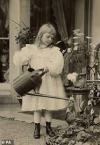
‘I’m afraid, Ma’am,’ said Nursie apologetically to mother the next day, ‘Miss Agatha can read.’ My mother was much distressed – but there it was. Not yet five, but the world of story books was open to me. From then on, for Christmas and birthdays I demanded books. Agatha Christie, An Autobiography
Some of her favorite writers – as she got older – were Elizabeth Bowen, Muriel Spark and Graham Greene. She liked to come up with her own plots during “ordinary life” goings-on.
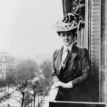
The really safe and satisfactory place to work out a story in your mind is when you are washing up. The purely mechanical labour helps the flow of ideas and how delightful to find your domestic task finished with no actual remembrance of having done it! Agatha Christie, An Autobiography
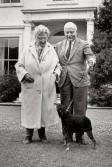
Plots come to me at such odd moments: when I am walking along a street, or examining a hat-shop with particular interest, suddenly a splendid idea comes into my head, and I think, ‘Now that would be a neat way of covering up the crime so that nobody would see the point.’ Of course, all the practical details are still to be worked out, and the people have to creep slowly into my consciousness, but I jot down my splendid idea in an exercise book. Agatha Christie, An Autobiography
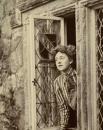
It never occurred to me to write anything down-and I was quite indifferent to what any[one] thought. I occasionally walk about nowadays muttering to myself – trying to get some chapter that won’t ‘go’ to come right. Agatha Christie, An Autobiography
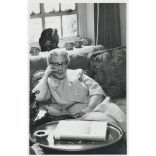
Agatha’s WRITING PROCESS (this is gathered from a few sources, but not deeply vetted): Many say that Agatha preferred to plot her crime stories from the murder itself. First, she would plan out the mode of murder, the killer, and the purpose. Second, she would factor in the various suspects and their own intents. Third, she would concoct potential clues and diversionary tactics to pull readers in different directions. Others report that Agatha constructed her stories back-to-front. She started with the ending and worked her way back from there. “This way, each of Christie’s novels marched swiftly along to a predestined conclusion and nothing about their plots ever seems random, misplaced, or fizzles out before the end.” (Jule aside: not sure I agree here.)
I have also “heard” that Agatha didn’t decide on the villain until nearer the end of the first draft. She created the problem and the characters and then asked herself – which is the LEAST LIKELY, which one would the reader NEVER SUSPECT. And then chose the character and went back to rework the book to make it “all fit”.
Anyone hear anything else on her process?
This holiday I hope to read her six books written under her pseudonym Mary Westamott. There are not crime mysteries – they are often characterized as romances – they seem like more studies of human nature and people. Here is what Agatha said about her favorite one: Absent in Spring:
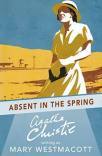
“Shortly after that, I wrote the one book that has satisfied me completely. It was a new Mary Westmacott, the book that I had always wanted to write, that had been clear in my mind. It was the picture of a woman with a complete image of herself, of what she was, but about which she was completely mistaken. Through her own actions, her own feelings and thoughts, this would be revealed to the reader. She would be, as it were, continually meeting herself, not recognising herself, but becoming increasingly uneasy. What brought about this revelation would be the fact that for the first time in her life she was alone – completely alone – for four or five days…. “I wrote that book in three days flat…I went straight through…I don’t think I have ever been so tired…I didn’t want to change a word and although I don’t know myself of course what it is really like, it was written as I meant to write it, and that is the proudest joy and author can have.”
AND NOW – IN PORTLAND MAINE!
Portland Stage (theatre on Forest Ave, downtown, near Empire Diner) is doing a production of MURDER ON THE LINKS, an adaptation of Christie’s book of the same name. It opens near the end of January. Anita Stewart, the head of the theatre, approached four Maine Crime-Mystery Writers who place their crime mysteries in Maine – and has put together a fun night. Actors will be reading from our books and then there will be a discussion about Agatha’s process, our processes, our love of the genre, Agatha’s legacy etc — I am excited to be part of it and hope some of you will come! January 9th, Thursday. 7 pm.
Here’s the blurb:
January 9th at 7 pm : A WARM UP to Portland Stage’s presentation of Agatha Christies’ Murder on the Links. Agatha is often (and deservedly) called the “Queen of Crime”. Agatha (with 2 billion books sold) is out-paced only by the Bible and Shakespeare. She’s a big reason why crime/mystery is one of the top-selling categories in fiction.
The work of four award-winning Maine crime/mystery writers will be presented. Some of Portland Stage’s favorite actors, directed by Todd Backus, will bring the work to life: Tess Gerritsen, best-selling author, Nero Wolf Award and Edgar Award nominee is known for the Rizzoli and Isles series and Spy Game (the first of the Camden Martini Club series); Ron Currie whose latest thriller The Savage, Noble Death of Babs Dionne follows multiple award-winning novels and short stories. Currie’s ‘Babs Dionne is a Franco-American crime matriarch who rules Waterville, Maine with an iron fist”; Portland’s Bruce Robert Coffin, former PPD (28 years, including time as detective on the Violent Crime Unit) and FBI (on the counter-terrorism unit) turned author who’s been finalist for the Agatha Award, won the Silver Falchion Award and other awards for his Portland Detective Byron Mysteries and short stories; Jule Selbo, former Hollywood screenwriter and author of the Dee Rommel Mystery Series that’s been awarded the Silver Falchion, nominated for Clue Award, Foreword Awards, and listed on Kirkus’ Top Five Crime Fiction novels from Small Publishers. “Dee Rommel is a private investigator – illuminating the ‘underbelly’ of Portland, Maine.”




After the actors bring sections of the writers’ novels to life, there’ll be a short talk-back about the work, Agatha Christie’s legacy and why crime-mysteries provide the puzzles readers love to solve. And of course – there will be the opportunity to gather in the lobby to grab a signed copy of a Maine writer’s mystery!
Thursday, January 9th, 7 pm. Tickets on sale now! $15
MainStage: Portland Stage, 25 Forest Avenue, Portland, Maine
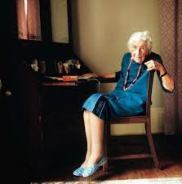 Here is Dame Agatha….
Here is Dame Agatha….
December 6, 2024
Weekend Update: December 7-8, 2024
 Next week at Maine Crime Writers there will be posts by Jule Selbo (Monday), Joe Souza (Tuesday), Vaughn Hardacker (Thursday) and Gabi Stiteler (Friday).
Next week at Maine Crime Writers there will be posts by Jule Selbo (Monday), Joe Souza (Tuesday), Vaughn Hardacker (Thursday) and Gabi Stiteler (Friday).
In the news department, here’s what’s happening with some of us who blog regularly at Maine Crime Writers:
Kathy Lynn Emerson: The revised edition of Face Down Beside St. Ann’s Well (trade paperback and included in the updated omnibus e-book, The Face Down Collection Three) is now available. It can be ordered through your local bookstore or library. This time it’s Lady Appleton’s twelve-year-old foster daughter, Rosamond, who leads her into danger. The story is set at the baths in Buxton, Derbyshire in 1575, and several real historical figures, including the infamous Bess of Hardwick, make appearances in the story. The Bangor Daily News called this one “one of her best” and I Love A Mystery said it is “an enjoyable, tightly plotted gem of a novel which will keep the reader guessing until the very last page.”
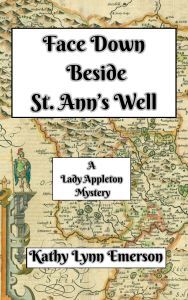
Maureen Milliken and Vaughn Hardacker both have tables at the Central Aroostook Chamber of Commerce Winter Holiday Fair this weekend, at the Sargent Community Center, 24 Chapman Road, Presque Isle. The show is 9 a.m.-4 p.m. Saturday and 9 a.m.-2 p.m. Sunday. It’s a great show with tons of vendors! If you’re in the area, stop by and say hi.
An invitation to readers of this blog: Do you have news relating to Maine, Crime, or Writing? We’d love to hear from you. Just comment below to share.
And a reminder: If your library, school, or organization is looking for a speaker, we are often available to talk about the writing process, research, where we get our ideas, and other mysteries of the business, along with the very popular “Making a Mystery” with audience participation, and “Casting Call: How We Staff Our Mysteries.” We also do programs on Zoom. Contact Kate Flora
Dear Anonymous-Read my Bumper

John Clark looking at a couple recent anonymous comments on the blog and figuring it’s time to address them. This pair of Chinese curses are in full array right now; “May You Live In Interesting Times,” and “May You Find What You Are Looking For.”
Right now, I’m creating my entry (I may do more than one) for a proposed anthology called Retribution and Revenge https://bcubedpress.moksha.io/publication/retribution-and-revenge The recent election not only shattered democracy (checks and balances have been turned into a bad joke), it created so many possibilities for horror, dystopia, and even mystery, both in short stories and full length fiction.
Looking into the dark crystal known as the future, I see nobody willing to harvest crops, work as hospital aides, or housekeeping staff (ditto hotels and motels) Are you ready to get up right after surgery to empty your own catheter? Think 2024’s weather was a shit show, what will it be like after ‘drill, baby, drill’? Got ocean front property? I hope it’s at least 20 feet above the high tide line. All the political gesturing in the world isn’t gonna hold back a storm surge, Category 5 hurricane, similar tornado, or wildfire.
Homeless, pregnant, on the LGBTQIA spectrun? Too bad, you ain’t got no rights in the MAGA world, but we’ll still include you as characters in our books and stories…That is until the (not so) supreme court decides that the current administration has the right to ban any books considered seditious. (Better get used to reading the bible)
Here’s a bit about a book I’m currently reading that is where the future of YA fiction will head, IMHO. Unbecoming / Seema Yasmin Simon & Schuster Books for Young Readers (July 9, 2024) 9781665938440
In a not-too-distant America, abortions are prosecuted and the right to choose is no longer an option. But best friends Laylah and Noor want to change the world. After graduating high school, they’ll become an OBGYN and a journalist, but in the meantime, they’re working on an illegal guide to abortion in Texas.
In response to the unfair laws, underground networks of clinics have sprung up, but the good fight has gotten even more precarious as it becomes harder to secure safe medication and supplies. Both Laylah and Noor are passionate about getting their guide completed so it can help those in need, but Laylah treats their project with an urgency Noor doesn’t understand—that may have something to do with the strange goings-on between their mosque and a local politician.
Fighting for what they believe in may involve even more obstacles than they bargained for, but the two best friends will continue as they always have: together.
As much as I support a free press, the number of requests I got this month, asking for contributions to keep Maine newspapers going, is depressing. Maybe get ready to tune in to Faux News; After all, they’re fair and unbiased.
I did a couple keyword searches in MaineCat, the online library database here in the state. Searching for politics and mystery netted 293 gits. Granted, some are duplicates (different editions/versions of the same item), but when I used political and mystery, the number jumped to 699.
I have this dark vision that shortly after Trump deports everyone he thinks is here illegally, the reality that no one’s left to do agricultural labor will cause considerable unrest. That’s when J.D. Vance steps forward with his New America plan which will fly through the house and senate. Imagine a new conscription of everyone still owing college debt. Heads shaved and wearing Trump inspired orange jumpsuits, they’re bussed around from crop to crop, picking for years until their debts are paid (at minimum wage, of course)
I can see John Nance Garner, somewhere in the afterlife remarking as he did about the vice presidency nearly a century ago, only this time muttering that the Trump administration is “not worth a bucket of warm spit.”
What’s your take on all this, good readers?

December 4, 2024
My Evergreen December Post
December 4, 2024: I love a good evergreen tree, and there’s a beauty tucked in our garage right now, hauled home today from our local holiday tree seller’s lot before tonight’s snow/sleet/rain. Inhaling that memory-evoking balsam scent inspired me to once again go evergreen with my December blog post.
This first was published on December 19, 2019, and I reprised it once already, in 2021. It still feels relevant to me. I hope you agree, and that you’ll forgive me for not coming up with something fresh, but we’re still finishing up the Thanksgiving turkey, and somehow, three weeks from tomorrow is Christmas and the first night of Hanukkah.
I wish everyone in our wonderful community a holiday season and a new year filled with love and hope.
**
December 19, 2019
Our neighborhood is especially bright with holiday lights this year, a reflection, perhaps, of a shared yearning to lessen the darkness in our world.
Before the recent snow, we strung some white lights around the yard, but it was far too early to hang the garland around the front door. Now I’m hoping it’s not too late, because the greenery around the entry makes the house look so festive. We’ve done the ladder-on-ice thing once or twice in the past, but we’re getting smarter as we age, so here’s to a couple of warmish days ahead.
This weekend we’ll get our tree. The ritual around that has changed as well. Up to and including the year I had knee surgery in early December, we cut our own at a tree farm a few miles west of our home. I say “we,” but that year I ventured out into the field and picked out an absolutely perfect tree (I was walking okay by then, albeit with a crutch) but Diane had to kneel on the frozen ground and cut it (the doctor would have frowned on me doing that).
She also had to drag it back to the car, which turned out to be a fair distance away. She was a good sport about it, but let’s just say I was convinced by the following December that there were easier ways to proceed, and since then we’ve bought a tree at a local nursery. They have a nice selection. The helpful staff gives the stump a fresh cut. They tie it on the roof of the car. It costs a little more, but aching knees have their own price, so off to the tree store we will go.
That night or the next, we’ll haul the lights, garlands and ornament boxes up from the basement and transform the tree into the most beautiful one ever.
Here are some of the ornaments we will hang:

A Claddagh, the Irish symbol of love, loyalty and friendship.
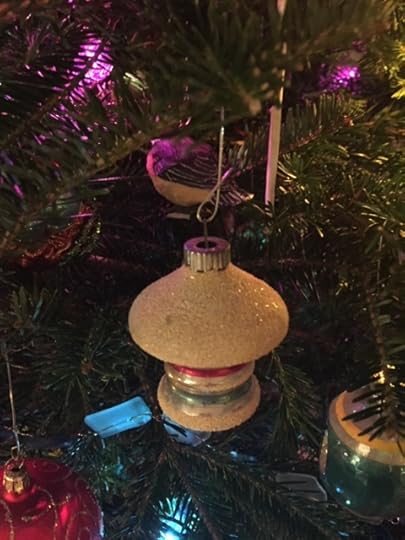
A precious, retro ornament from Diane’s childhood.
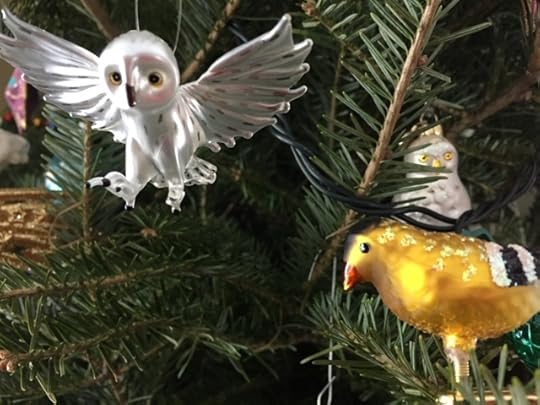
We love bird ornaments. Here, a snowy owl visits with a goldfinch, while another owl spies from the background.

Oh, Canada! We were married there nearly 15 years ago, so this one always has a place of honor on our tree.

Many readers of this blog have one of these, am I right?
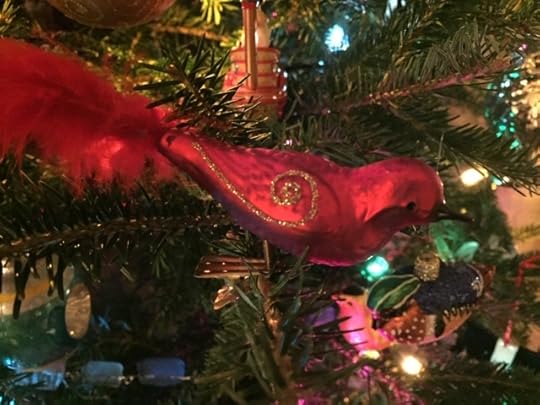
A very fancy bird, indeed.
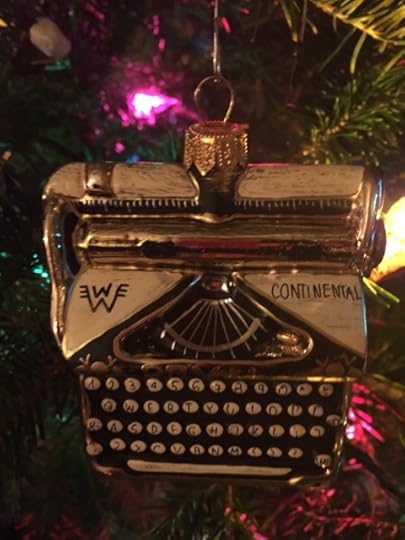
But of course.
I wish you happiness this season and a joyous, peaceful, healthy new year.
To the readers of this blog: What are your favorite holiday traditions? Please let us know in the comments.
Brenda Buchanan is the author of the Joe Gale Mystery Series, featuring a diehard Maine newspaper reporter who covers the crime and courts beat. Three books—QUICK PIVOT, COVER STORY and TRUTH BEAT—are available everywhere e-books are sold. She is writing a new series that has as its protagonist a Portland criminal defense lawyer willing to take on cases others won’t touch in a town to which she swore she would never return.
December 3, 2024
Illuminations for the Season of Dark
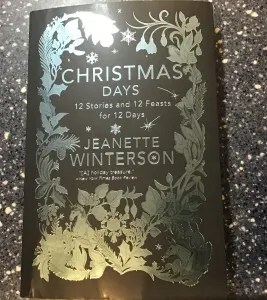 Kate Flora: I’ve probably said this here too much, that for my writing, when I’m looking for fresh images, fresh language, or a new way of illuminating my scenes or my characters, or to create a mood, I will turn to poetry books. (I also turn to them for titles when a book refuses the name I’ve given it.) Sometimes there will be so many books scattered on the floor around my desk that I have to practically hop on one foot to get out of the room.
Kate Flora: I’ve probably said this here too much, that for my writing, when I’m looking for fresh images, fresh language, or a new way of illuminating my scenes or my characters, or to create a mood, I will turn to poetry books. (I also turn to them for titles when a book refuses the name I’ve given it.) Sometimes there will be so many books scattered on the floor around my desk that I have to practically hop on one foot to get out of the room.
Right now, as a treat for the holiday season, I am reading Jeanette Winterson’s Christmas Days: 12 stories and 12 Feasts for 12 Days. So far, I’ve learned a lot about Christmas that I hadn’t known. That the Puritans banned it. That the reason Santa’s suit is red is because of a coca cola ad. That the Christmas tree, which I always assumed was a long time continuation of pagan solstice celebrations, became popular in 1848 when Victoria and Albert posed beside their holiday tree. I haven’t even gotten to the stories yet, but I’m hoping for inspiration there, since I write a Christmas story every year and the clock is running.
But I said this was about illuminations, didn’t I, which also brings us in touch with the darkness. So here are some poems for this season to read and ponder on.

To Know the Dark by Wendell Berry
To go in the dark with a light is to know the light.
To know the dark, go dark. Go without sight,
and find that the dark, too, blooms and sings,
and is traveled by dark feet and dark wings.
Snowy Night by Mary Oliver
Last night, an owl
in the blue dark
tossed an indeterminate number
of carefully shaped sounds into
the world, in which,
a quarter of a mile away, I happened
to be standing.
I couldn’t tell
which one it was –
the barred or the great-horned
ship of the air –
it was that distant. But, anyway,
aren’t there moments
that are better than knowing something,
and sweeter? Snow was falling,
so much like stars
filling the dark trees
that one could easily imagine
its reason for being was nothing more
than prettiness. I suppose
if this were someone else’s story
they would have insisted on knowing
whatever is knowable – would have hurried
over the fields
to name it – the owl, I mean.
But it’s mine, this poem of the night,
and I just stood there, listening and holding out
my hands to the soft glitter
falling through the air. I love this world,
but not for its answers.
And I wish good luck to the owl,
whatever its name –
and I wish great welcome to the snow,
whatever its severe and comfortless
and beautiful meaning.
The Shortest Day by Susan Cooper
So the shortest day came, and the year died,
And everywhere down the centuries of the snow-white world
Came people singing, dancing,
To drive the dark away.
They lighted candles in the winter trees;
They hung their homes with evergreen;
They burned beseeching fires all night long
To keep the year alive,
And when the new year’s sunshine blazed awake
They shouted, reveling.
Through all the frosty ages you can hear them
Echoing behind us—Listen!!
All the long echoes sing the same delight,
This shortest day,
As promise wakens in the sleeping land:
They carol, feast, give thanks,
And dearly love their friends,
And hope for peace.
And so do we, here, now,
This year and every year.
Welcome Yule!
Approaching Solstice by Patricia Monaghan
Yes, friends, the darkness wins but these
short days so celebrate light:
today, the lemon sunrise lasted a few
hours until sunset, all day the snow
glowed pink and purple in the trees.
This is not a time of black and white.
My friend, outside us, among us too,
let’s sing what winter forces us to know:
Joy and colour bloom despite the night.
We measure warmth by love, not by degrees.
Lea Wait's Blog
- Lea Wait's profile
- 508 followers



